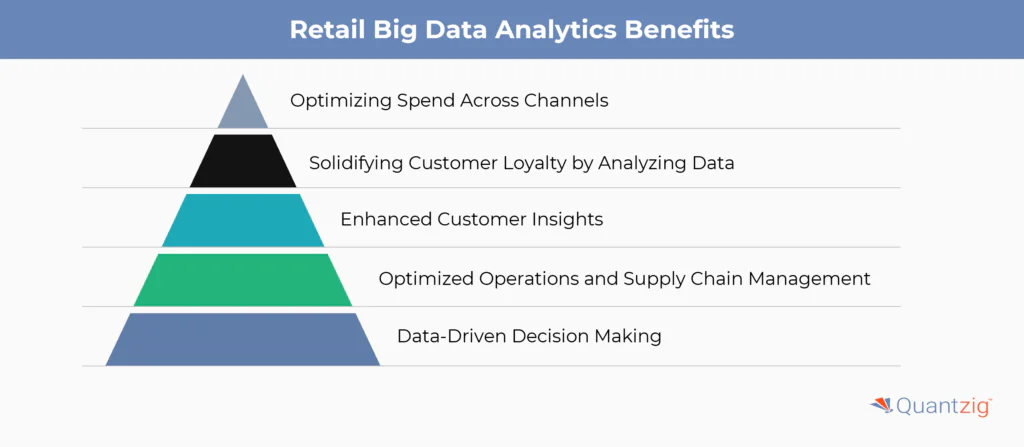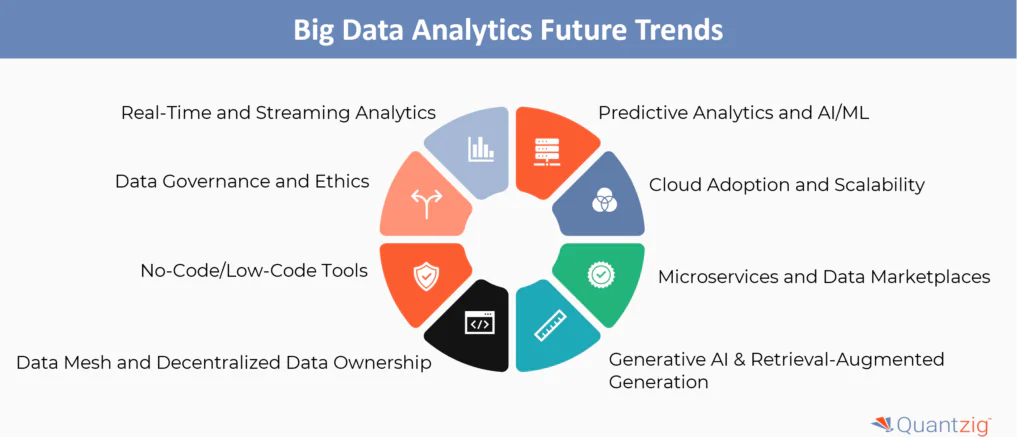When it comes to leveraging big data analytics in retail, several factors and statistical techniques determine success—including data mining, predictive modeling, machine learning, and data modeling. Retailers that have effectively embraced these approaches have emerged as industry leaders. This article presents real-world big data analytics success stories from the front lines, showcasing how major retailers have used data to drive meaningful business improvements.
From boosting customer loyalty to optimizing inventory, these big data in retail examples reveal the tangible value of analytics. Let’s dive into how analytics transforms retail operations.
Book a demo to experience the meaningful insights we derive from data through our analytical tools and platform capabilities!
Request a Free DemoTable of Contents
What is Big Data Analytics?
Big data analytics is the process of examining large, complex datasets to uncover hidden patterns, correlations, and insights. It involves advanced techniques like machine learning and predictive modeling to extract actionable intelligence from massive volumes of data generated by various sources.
Importance of Big Data Analytics in Retail
In retail, big data analytics plays a transformative role. It allows businesses to understand customer behavior, optimize operations, and make smarter strategic decisions. Successful big data analytics success stories often highlight how retailers can personalize customer experiences, improve supply chain efficiency, and drive profitability.
Uses of Big Data Analytics in Retail

1. Optimizing Spend Across Channels
The retail industry constantly navigates trade-offs—such as balancing pricing with quality, or managing inventory and warehousing costs against the risk of stock-outs. While these decisions were once made with relative ease, the growing volume and complexity of data have made such analysis increasingly challenging. In today’s dynamic retail landscape, optimizing spend across multiple channels is no longer straightforward; however, the use of big data analytics in the retail industry helps eliminate much of the guesswork, enabling more informed decisions and enhancing the overall customer experience.
2. Solidifying Customer Loyalty by Analyzing Data
Big data analytics in the retail industry plays a crucial role in understanding customer behavior and sentiment through a structured, data-driven approach. Advanced data analytics models not only provide detailed insights into opportunities and risks but also help retailers identify the root causes of issues, enabling more targeted and effective strategies.
3. Enhanced Customer Insights
With the help of big data analytics, retailers can collect and analyze vast amounts of consumer data from various sources, including transactions, social media, and loyalty programs. By understanding customer behavior, preferences, and purchase patterns, retailers can personalize product offerings, incentives, and marketing strategies to effectively target specific consumer segments—resulting in improved customer satisfaction, stronger loyalty, and higher conversion rates.
4. Optimized Operations and Supply Chain Management
- Big data analytics can be used by retailers to improve supply chain logistics, demand forecasting, and inventory management.
- Retailers may more effectively estimate demand and guarantee ideal inventory levels by examining past sales data, market trends, and outside variables like weather patterns.
- Big data analytics also helps retailers cut expenses, eliminate stockouts, optimize their supply chain procedures, and boost overall operational effectiveness.
5. Data-Driven Decision Making
Big data analytics enables retailers to make data-driven decisions across various business functions, including pricing, merchandising, and store management. By leveraging advanced techniques such as machine learning and predictive modeling, retailers gain valuable insights into market trends, competitive intelligence, and customer behavior—allowing for more informed, strategic decision-making.
In the end, this data-driven strategy gives merchants a competitive edge and profitability by assisting them in spotting growth prospects, managing risks, and remaining flexible in the face of shifting market conditions.

Experience the advantages firsthand by testing a customized complimentary pilot designed to address your specific requirements. Pilot studies are non-committal in nature.
Request a Free PilotWhat are the Best Practices for the Success Factor in Big Data Analytics?
To unlock the full potential of Big Data Analytics, it’s essential to follow proven best practices that drive success. These practices not only ensure the effective utilization of vast data resources but also help in deriving actionable insights that can significantly impact business outcomes. Let’s explore the key strategies that lead to successful Big Data Analytics implementations.
| Best Practice | Description |
|---|---|
| AI Integration | – Utilize AI to enhance big data analytics – Leverage advanced algorithms and pattern recognition capabilities for more accurate predictions and insights |
| Cloud Computing | – Implement cloud computing solutions like Snowflake – Ensure scalable and flexible data storage and processing for efficient management of large datasets |
| Data Analytics Strategies | – Develop robust data analytics strategies aligned with the overall data and analytics strategy – Ensure cohesive and goal-oriented data analysis efforts |
| Business Intelligence | – Leverage business intelligence tools to transform raw data into actionable insights – Enable data-driven decision-making across the organization |
| Machine Learning | – Incorporate machine learning techniques to automate data processing and uncover deeper insights – Improve the accuracy and efficiency of data analytics |
| CRM Data Integration | – Integrate CRM data to gain a comprehensive view of customer interactions and behaviors – Inform personalized marketing and customer service strategies |
| Data Lake Utilization | – Utilize a data lake to store vast amounts of structured and unstructured data – Provide a centralized repository that supports advanced analytics and machine learning models |
By adopting these best practices, organizations can harness the power of big data analytics to drive innovation, improve decision-making, and gain a competitive edge in their respective industries.
Quantzig’s Retail Big Data Analytics Success Stories
| Client | Challenge | Quantzig’s Approach | Key Outcomes |
|---|---|---|---|
| A Fortune 500 Fashion Retailer | – Challenges in integrating data from disparate sources – Needed to analyze data to improve brand recognition and profitability across channels | – Leveraged big data analytics to combine media, sales, and customer data sets – Analyzed data to identify the impact of social channels on sales | – Reallocated marketing spend to high-performing channels – Identified areas to improve customer experience and drive greater impact |
| A Leading Consumer Food Brand | – Needed to leverage data to drive improvements in key business areas – Wanted to develop an innovative data analytics model to analyze customer data | – Developed a data analytics model to analyze customer data – Helped strengthen customer loyalty and enhance sales | – Enabled the client to explore a new emerging market that relies on analytics as a core business asset |
| A Leading Specialty Goods Retailer | – Inefficient big data strategy, with a large portion of profits from a small customer base – Wanted to use big data analytics to identify the root cause and optimize pricing/discount strategies | – Integrated data and built predictive analytics models to identify high-potential customer segments – Analyzed pricing and discount strategies of competitors | – Able to analyze prices better and optimize strategies for different customer segments – Improved sales growth from larger customer segments |
In all three cases, Quantzig’s expertise in leveraging big data analytics in the retail industry helped the clients overcome their challenges, optimize their strategies, and drive significant business impact.

Get started with your complimentary trial today and delve into our platform without any obligations. Explore our wide range of customized, consumption driven analytical solutions services built across the analytical maturity levels.
Start your Free Trial TodayFuture Trends in Big Data Analytics

- Real-Time and Streaming Analytics: The ability to analyze data in real-time as it is generated has become increasingly vital in today’s fast-paced retail environment. Real-time and streaming analytics empower organizations to detect patterns, identify anomalies, and respond quickly to emerging trends, enabling proactive decision-making. With tools like Apache Spark, Kafka, and Amazon Kinesis, businesses can process large volumes of data instantly, gaining timely insights that drive competitive advantage. As part of broader big data analytics success stories, many retailers are adopting real-time analytics to enhance responsiveness and improve operational efficiency.
- Predictive Analytics and AI/ML: Predictive analytics, driven by machine learning (ML) and artificial intelligence (AI), plays a key role in forecasting future events and trends with high accuracy. By automating data processing and enhancing pattern recognition, AI-powered analytics enable businesses to make smarter, faster decisions. Common applications in retail include personalized product recommendations, predictive maintenance, and automated decision-making processes. These innovations are central to many big data analytics success stories, where retailers leverage AI/ML to stay ahead of customer expectations and market shifts, making data not just insightful—but actionable..
- Data Governance and Ethics: As the use of big data grows, there is an increased focus on data privacy, security, and the ethical use of data to foster trust and transparency. Establishing strong data governance frameworks ensures that data remains high-quality, compliant, and managed responsibly throughout its lifecycle. Additionally, addressing concerns about algorithmic bias and ensuring transparency in data usage are critical to maintaining ethical standards. These practices are essential for businesses looking to build credibility and protect customer trust in their big data analytics success stories, as they navigate the complexities of data-driven decision-making in an ethical manner.
- Cloud Adoption and Scalability: The migration of big data infrastructure to the cloud has become a key trend, offering enhanced scalability, flexibility, and cost-effectiveness for businesses. Cloud-based solutions such as data lakes, data warehouses, and analytics platforms empower organizations to efficiently manage growing volumes of data. This transition to cloud infrastructure enables retailers to scale their data operations seamlessly, making it easier to store, process, and analyze large datasets. In big data analytics success stories, leveraging the cloud is helping businesses optimize their operations and stay ahead in a data-driven world.
- Data Democratization and No-Code/Low-Code Tools: Data democratization is empowering business users to access and analyze data independently, without the constant need for data science teams. The adoption of user-friendly, no-code and low-code analytics platforms is helping to democratize data-driven decision-making, allowing employees across departments to leverage insights without deep technical expertise. This shift enables faster, more agile decision-making and encourages a culture of data-driven innovation. In big data analytics success stories, businesses embracing no-code and low-code tools are seeing improved efficiency and a more inclusive approach to data utilization.
- Microservices and Data Marketplaces: This approach enables organizations to quickly adapt to changing business needs and efficiently manage their data infrastructure. Additionally, data marketplaces provide access to a wide range of external data sources, enriching analytics capabilities and offering new insights. In big data analytics success stories, leveraging microservices and data marketplaces allows businesses to enhance their data-driven strategies and drive more informed decision-making.
- Data Mesh and Decentralized Data Ownership: The shift towards a decentralized, domain-driven approach to data management and governance, known as the data mesh, is gaining momentum. This model empowers cross-functional teams to take ownership of the data relevant to their specific business domains, enabling more efficient and effective data management. By decentralizing data ownership, organizations can foster greater accountability and agility in their data practices. In big data analytics success stories, this approach helps businesses unlock faster insights, streamline operations, and drive innovation through a more collaborative and flexible data strategy.
- Generative AI and Retrieval-Augmented Generation (RAG): Generative AI is revolutionizing the field of predictive analytics by creating synthetic datasets and automating content generation, opening up new possibilities for data visualization and trend forecasting. Additionally, Retrieval-Augmented Generation (RAG) enhances AI models by integrating real-time data retrieval, providing more accurate and contextually relevant insights. This combination of generative AI and RAG is transforming the way businesses analyze data, enabling them to deliver deeper, more precise insights. In big data analytics success stories, these advanced AI technologies are helping organizations gain a competitive edge through innovative data-driven strategies.
These trends highlight the evolving landscape of big data analytics, driven by advancements in technology, the need for real-time insights, and the growing emphasis on data governance, ethics, and democratization.
Conclusion
Realizing the full potential of big data analytics in retail begins with a strong strategic foundation. As shown in these big data analytics success stories, combining expert teams, robust strategies, and the right tools leads to transformative outcomes.
At Quantzig, we specialize in enabling success through customized solutions. Our extensive portfolio of services supports retailers at every stage of their analytics journey—ensuring your data works as hard as you do.




